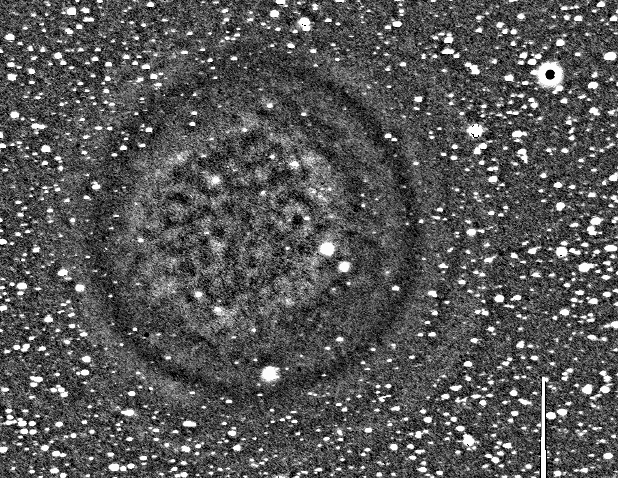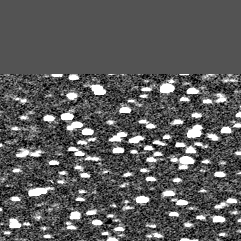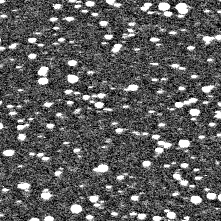


Above are the discovery images of the asteroid "Huikilolani", named in honor of the Hawaiian Astronomical Society. Huikilolani was discovered by Geophysicists Bill Dillon and myself, Joe Dellinger. On the left are the "discovery night" images, taken on the evening of Tuesday, July 10, 2001 (July 11 Universal Time). On the right are the "confirmation night" images, taken on the evening of July 19, 2001 (July 20 Universal Time). The first image in each animation is displayed twice as long as the rest.
To get credit for discovering an asteroid takes two independent set of observations. Data is seldom perfect (as you will see if you read on below); the requirement for two nights greatly reduces the chances of awarding designations to objects that are in reality mere data artifacts.
Both sets of images above were taken using the Fort Bend Astronomy Club's "East-dome" telescope located at the George Observatory, a Houston Museum of Natural Science satellite facility located inside Brazos Bend State Park. I have aligned the stacks and then cropped out an area centered on the object, adding grey padding beyond the edge of any images as necessary for all of them to remain the same size.
This asteroid was a classic case study in both good and bad luck!
Good luck! In the "South" field we had a very bright discovery candidate, which was to become "Svenders", one of our club's brightest discoveries ever.
Bad luck: In our scramble to get confirmation on that one, we did a rather cursory job looking for movers in the "North" field. If the data was divided up into 3, this object was merged with a star in the first image, and was very close to the edge in the second. We were also fighting bad tracking that night, which didn't help. We also had a time gap in the data: it is more difficult to detect regular motion if you blink images that are not regularly spaced apart in time, because regular motion then appears to be irregular. Whatever the reason, we simply missed noticing it, and then both Bill and I ended up traveling in the next week. (We have since learned to scan the edges of images particularly carefully, as it is very easy to overlook objects there.)
When I got back from my trip I decided to double check the data "just in case", and noticed the overlooked object.
Really good luck: It was still a discovery candidate! By rearranging how the (mostly) continuous stream of 2-minute raw images was divided and grouped into stacks, I was able to get 3 usable points on the object.
Bad luck: By the time we could next try to image the object, 9 days would have passed. That is usually too long of a time gap for a confirming observation.
Len Casady (another team member) and I got out 9 days after the discovery night, set up the camera, and tried to image the predicted location of the asteroid.
Really bad luck: At that time we were still working our way up the learning curve of our AP8 camera, and we hit a major snag. The camera contains dessicant to keep its insides dry, which is supposed to be replaced once a year or so. This probably works very well on cold dry mountaintops. Our observatory, however, is located just above sea level on the Gulf Coast of Texas in the middle of a large swamp (think "giant outdoor sauna" in July). The camera has an internal cooler; the colder you can get the camera, the less noise in the data. Generally -20C is about the warmest you ever want to do imaging. As we cooled the camera that night, a nasty ring formed in the middle of the image and grew and grew. Condensation was forming inside the camera!

Here is an image of the dreaded "frost ring", taken from our confirmation night data. It's not really frost, but water condensation on the optical surfaces inside the camera. The "total solar eclipse" to the upper right is a bad spot on our CCD chip. The presence of such bad spots makes our CCD "amateur grade" instead of "professional grade". Why put up with such bad spots on your camera chip? Because chips where every pixel works perfectly are much more expensive! Bad spots in the camera chip become artifacts in the processed data, but artifacts that are obviously artifacts are no big deal: just ignore them, and no harm done. The only dangerous artifacts, the ones you really have to be careful of, are the ones that look just like stars (and we have a few of those). The vertical white line is growing up from a saturated too-bright star off the bottom of this cropped image. That star is causing "blooming", a known problem with almost all CCD chips.
The formal procedure would have been to warm the camera, take the camera apart, put in fresh dessicant, and then cool the camera down again. That would have taken about 2 hours to accomplish, time we didn't have. (We have since learned to store the camera surrounded by industrial-grade room dessicant packs, all inside 2 layers of hermetically sealed bags, inside a hermetically sealed case.) So instead, we warmed the camera to -15C, so that the frost ring retreated back to covering only the center of the image, and then positioned the predicted position of the asteroid in the center of the corner of the image farthest away from the ring. We then cropped off and used just the good parts of the data from around the edges of the image.
Really good luck: That actually worked! Even after 9 days, the asteroid was still close enough to its predicted position that we got it in the small field left to us. It was also bright enough to have a decent image despite the too-hot camera. Although it was perilously close to the edge of the field, it was inside.
Bad luck: It was again very close to a star when we first started shooting it, so much of our data was not usable.
Good luck: I had brought my computer out to the observatory with me. We processed the data immediately after taking it. It was a little while before we realized that the bright, easy object near the very edge of the field was our discovery candidate. The dim, difficult object just above it that we had been struggling to pull out of the noisy data was in fact a long-known numbered object not really in need of our observation. Once we realized that, we knew all we needed to do was to go back and shoot the field again for a little bit more time before tearing down! (Note the big jump the asteroid takes in the last frame of the confirmation-night animation above.)
(Test yourself! Now that you know it's there, can you find numbered asteroid 14847 in the confirmation-night image above? Hint: It's above and to the left of Huikilolani and traveling on a roughly parallel course. Use Huikilolani as a guide as to how it should jump between frames. It's very dim in the first image, too dim to really see, and in the last image a star-like artifact confusingly appears from nowhere right next to it. At magnitude 19.0, 14847 should have been an easy object in this data. It's not, and that is because the camera was so hot! Huikilolani is more than a full magnitude brighter in this image, which is why it's an easy object.)
Bad luck: Bill was still out of town, and would be for a few more days, and all communications to and from the Minor Planet Center were usually funneled through him. We e-mailed in the data ourselves and hoped for the best. The replies went back to him, so we did not find out for several days what the result was.
Astoundingly good luck: Once Bill got back, he was able to tell us that they had accepted our pair of nights and we got the discovery, 2001 NP14! We have never before nor since gotten a discovery from such a widely spaced pair of nights. (If you're wondering, that designation "2001 NP14" is just MPC shorthand for "the 389th asteroid discovered worldwide in the first half of July, 2001".)
It generally takes years of following an object before the orbit is well enough nailed down that the object is given a permanent number. Only then is the object namable.
More good luck: 2001 NP14 became eligible for naming somewhat faster than usual, because after it went to two oppositions, allowing its orbit to be extrapolated across multiple years, an observation was found for it way back in 1982. That really helped to nail down its orbit. Without that data point, the object would probably not yet be numbered.
Here asteroid Huikilolani was accidentally caught wandering through an Australian sky-survey image taken on Oct 12, 1982. It's the diagonal streak in the center of the image. The length of the exposure is 65 minutes. Precovery image found by Andrew Lowe.
I had lived in Honolulu, Hawaii 1991-1994 and have fond memories of the astronomy club there, the Hawaiian Astronomical Society. I had been thinking for a while that I should honor the club with an asteroid. But which asteroid to use? July 11, 1991 was the date of the great total eclipse which I witnessed, successfully, from the Big Island. This asteroid was discovered on the 10th anniversary of that event, so it seemed fitting that this asteroid should be given a Hawaiian name. Bill Dillon agreed.
One final bit of good luck: The CSBN accepted our proposed name for (88297) 2001 NP14. (It was by no means guaranteed that they would!)
Here is the official citation:
Huikilolani 88297 The slogan of the Hawaiian Astronomical Society
(88297) Huikilolani = 2001 NP14
Discovered 2001 Jul. 11 by J. Dellinger and W. G. Dillon at Needville.
Founded in 1949, the Hawaiian Astronomical Society exists to promote amateur
astronomy in Hawaii. Hui Kilolani is the club's slogan. Literally, it means
"club of sky watchers".
Here is an orbital animation of Huikilolani, courtesy JPL.
For the more technically minded, the official orbital elements, residuals, and ephemerides for the discovery and confirmation nights from the MPC are given below. The orbital elements show that it's a typical main-belt asteroid, with a semi-major axis of a=2.17 astronomical units, a moderate eccentricity of e=16%, and a smallish orbital inclination of 4 degrees.
The "residuals" are misfits between the raw observations turned into the MPC and their best-fitting orbit, in seconds of arc. There are two columns: first the misfit in right ascension (East-West), then declination (North-South). Our observatory is MPC code 735 ("Needville", the nearest named town to the park). The residuals tell a story once you know how to read them.
In 2001, you can see code 608 (Haleakala-AMOS, a professional survey) observed the object a couple of weeks before we did, but they did not get the necessary confirmation night, so no discovery. On the other hand, if we had waited just one more day to get our own confirmation night, then they could have scooped us in turn if they promptly turned in their July 21st observation.
In 2003, note how we searched for and found Huikilolani on a pair of nights in early January, successfully recovering it at its next opposition after discovery. Our residuals weren't the best, though, and we only got two observations the second night instead of the preferred three. What was the problem? An opposition in early January means a Winter Milky Way star field crowded with tens of thousands of stars. The difficulty is catching a clear image of the asteroid during one of the intervals when it briefly peeks out between the wall-to-wall stars. We did pretty well, relatively: nobody else observed the object even once that entire opposition! Two observations is the minimum acceptable for a single night, and two nights is the minimum acceptable for a 2nd-opposition orbital update. We managed to accomplish that with one observation to spare.
Next look at 2004: the overwhelming dominance of code 704 ("Lincoln Laboratory ETS, New Mexico", a.k.a. LINEAR) becomes clear. Our brighter objects we hardly have to follow anymore: LINEAR observes them for us. Again and again and again. And again. Although LINEAR doesn't cover the deep Southern skies, Siding Spring survey in Australia (code E12) now does. These days the ecliptic region of the sky is being vacuumed rather thoroughly. While magnitude 18 may seem awfully dim to a visual observer, in fact undiscovered asteroids as bright as Huikilolani are getting very few and far between.
How big is Huikilolani? According to the MPC, Huikilolani, with an absolute magnitude H=16.9, should be about 1-2km's in diameter.
(88297) Huikilolani
Epoch 2006 Mar. 6.0 TT = JDT 2453800.5 MPC
M 167.96465 (2000.0) P Q
n 0.30901462 Peri. 53.42737 +0.35255377 +0.93371736 T = 2453256.95080 JDT
a 2.1667894 Node 237.32967 -0.88047173 +0.30843678 q = 1.8176353
e 0.1611389 Incl. 4.24233 -0.31697851 +0.18176534 Earth MOID = 0.80503 AU
P 3.19 H 16.9 G 0.15 U 1
From 69 observations at 4 oppositions, 1982-2004, mean residual 0".70.
Residuals
19821012 413 0.4- 1.3+ 20010817 735 0.7+ 0.2- 20040517 704 0.2- 0.1+
19821012 413 0.5- 1.1+ 20010817 735 0.2+ 0.6+ 20040517 704 0.2- 0.1+
20010629 608 0.2- 0.8- 20010912 704 0.6+ 0.2+ 20040517 704 0.9- 0.9+
20010629 608 0.1- 0.6- 20010912 704 0.2+ 0.4- 20040517 704 0.6- 0.9+
20010629 608 0.3- 0.3- 20010912 704 1.2- 0.7- 20040519 704 1.5+ 0.1-
20010711 735 0.1+ 0.5- 20010912 704 0.0 0.3+ 20040519 704 1.9+ 0.1+
20010711 735 0.3- 0.2- 20030102 735 0.6+ 1.6+ 20040519 704 1.4+ 0.9+
20010711 735 0.0 0.4+ 20030102 735 0.1+ 2.1+ 20040519 704 1.6+ 0.1+
20010717 608 0.5- 0.2+ 20030102 735 0.1+ 2.1+ 20040519 704 0.9+ 0.2+
20010717 608 0.5- 0.3+ 20030103 735 0.1+ 1.1+ 20040611 704 0.5- 1.5-
20010717 608 0.4- 0.3+ 20030103 735 0.0 0.1+ 20040611 704 0.1- 0.1+
20010720 735 0.5+ 0.2+ 20040515 704 0.9- 0.1+ 20040611 704 0.4- 0.2-
20010720 735 0.3+ 0.1+ 20040515 704 1.1- 0.1+ 20040611 704 0.4- 1.7-
20010720 735 0.9+ 0.2- 20040515 704 0.6- 0.0 20040614 704 0.6- 0.7+
20010721 608 0.4- 0.9+ 20040515 704 0.0 0.0 20040614 704 0.2+ 0.8+
20010721 608 0.7- 0.8+ 20040515 704 0.2+ 0.2- 20040614 704 0.3- 1.1+
20010721 608 0.5- 0.7+ 20040516 704 0.4- 0.6+ 20040614 704 0.2+ 0.3+
20010722 735 0.6+ 0.5+ 20040516 704 0.2+ 0.1+ 20040614 704 0.1- 0.7+
20010722 735 0.0 0.5+ 20040516 704 0.5+ 1.9- 20040714 E12 0.5- 0.2+
20010722 735 (2.0+ 0.1+) 20040516 704 0.6- 1.0+ 20040714 E12 0.1+ 0.0
20010727 608 0.0 0.3- 20040517 704 0.5- 0.1- 20040714 E12 0.5- 0.2+
20010727 608 0.1+ 0.3- 20040517 704 1.8+ 0.6+ 20040714 E12 0.5+ 0.1+
20010727 608 0.2- 0.6- 20040517 704 0.8- 0.1-
20010817 735 0.7+ 0.3+ 20040517 704 0.3- 0.1+
Last observed on 2005 Dec. 8. Perturbed ephemeris below based on elements from MPO 63795.
Discovery date : 2001 07 11
Discovery site : Needville
Discoverer(s) : Dellinger, J., Dillon, W. G.
Further observations? None needed at this time.
0088297
Date UT R.A. (J2000) Decl. Delta r El. Ph. V Sky Motion Object Sun Moon
h m s "/min P.A. Azi. Alt. Alt. Phase Dist. Alt.
2001 07 11 050000 20 13 37.5 -11 42 28 0.818 1.817 163.9 8.9 18.4 0.55 273.0 316 +37 -35 0.74 049 +01
2001 07 20 050000 20 05 31.3 -11 41 53 0.809 1.819 170.9 5.1 18.2 0.61 267.2 327 +43 -36 0.01 165 -36
Finally, here are the official discovery-night data for Huikilolani. This is what actually gets turned into the MPC: not images! All that work, observation, processing, and data reduction, in the end boils down to a few cryptic lines of numbers (which must be arranged very particularly in columns just so).
COD 735
OBS W. G. Dillon, J. Dellinger
MEA J. Dellinger
TEL .46m Newtonian + CCD
NET USNO-A2.0
ACK More July 11 data. OBS discoverers if unknown.
F17115 * C2001 07 11.20032 20 13 37.95 -11 42 29.0 18.1 R 735
F17115 C2001 07 11.22960 20 13 36.35 -11 42 27.5 17.7 R 735
F17115 C2001 07 11.23593 20 13 36.03 -11 42 26.6 17.9 R 735
Mahalo for the good times and fond memories, HAS!